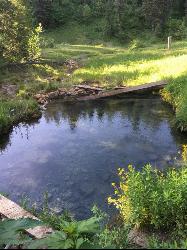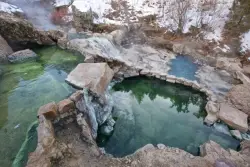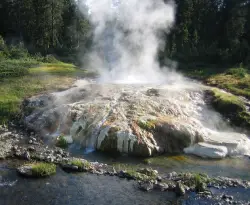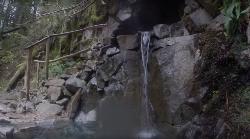Hot Spring Soaking
"Escape the mundane and immerse yourself in the natural world with a visit to a wild hot spring. These geothermal wonders, found in locations all over the globe, offer a chance to relax and rejuvenate in a beautiful outdoor setting. But as with any outdoor adventure, it's important to practice leave no trace principles to ensure the preservation of these natural wonders for generations to come.
So, where can you find these wild hot springs? They can be found in many different landscapes, from the snowy mountains to the arid desert. Some popular destinations include Yellowstone National Park in the United States, Rotorua in New Zealand, and Pamukkale in Turkey.
But what makes a hot spring "wild"? Wild hot springs are those that are not developed or commercialized, offering a more rustic and natural experience. These springs may not have amenities such as changing rooms or developed pools, but that's part of their charm.
So why visit a wild hot spring? For one, it's a chance to disconnect from technology and daily life and reconnect with nature. The warm, soothing waters are also believed to have health benefits, such as easing muscle tension and improving circulation.
When visiting a wild hot spring, it's important to follow leave no trace principles to minimize your impact on the environment. This includes packing out all trash, respecting wildlife and plant life, and not altering the area in any way.
Now that you know the what, where, and why of wild hot springs, it's time to start planning your adventure. Do some research to find a spring in a location that appeals to you, and be sure to follow all leave no trace guidelines to ensure a responsible and enjoyable experience for all."
Here's some of our favorite hot springs

Bear Creek Hot Springs
Irwin, Idaho
9.8 miles S of Irwin, IdahoBear Creek Hot Springs is a 15 mile out and back trail with a hot spring at the end. The trail is not well marked and is only recommended for very experienced outdoorsmen and primarily used for...
Backpack, Camp, Hike, Horseback, Hot Springs, Mountain Bike
Meadow Hot Spring
Meadow, Utah
5.4 miles W of Meadow, UtahThe springs are located on private property but the owners have been gracious enough to allow public access. As always, please be gracious respectful in return and if you pack it in, pack it out....
Hot Springs, Swim 4.7 mi
Fifth Water Hot Springs
Provo, Utah
19.0 miles SE of Provo, UtahAKA Diamond Fork Hot Springs A beautiful drive and a 2.5 mile hike along the river will end you at an amazing set of hot springs that's well worth the trip. There's a variety of...
Backpack, Camp, Hike, Hot Springs, Mountain Bike, Swim
The Rock Tub Hot Springs
Whitmore Hot Springs, California
1.1 miles N of Whitmore Hot Springs, CaliforniaNestled amidst the breathtaking landscapes of Mammoth Lakes, California, lies a hidden gem that beckons seekers of relaxation and natural beauty. The Rock Tub Hot Springs, a serene and rejuvenating...
Hot Springs 14.8-30.2 mi
Mr. Bubbles Hot Spring
Old Faithful, Yellowstone National Park
24.0 miles SW of Old Faithful, Yellowstone National ParkMr. Bubbles is one of the few places you can actually soak in the thermal waters of Yellowstone National Park. The Bechler area of Yellowstone is one of the best kept secrets of the otherwise densely...
Hike, Hot Springs 15.9-16.6 miUnion Falls & Ouzel Pool
Grant Village, Yellowstone National Park
26.6 miles SW of Grant Village, Yellowstone National ParkBackpack, Hike, Hot Springs, and Swim near Grant Village, Yellowstone National Park
Backpack, Hike, Hot Springs, Swim 7.0 mi
Goldmyer Hot Springs Trail
North Bend, Washington
18.4 miles E of North Bend, WashingtonGoldmyer Hot Springs Trail is a difficult hiking trail up to the famous Goldmyer Hot Springs. The hike is free to access and great for those who want to enjoy a remote hiking...
Hike, Hot Springs
Bonneville Hot Springs
Lowman, Idaho
16.0 miles E of Lowman, IdahoBonneville Hot Springs are a series of soaking pools that are the most popular activity for visitors to Bonneville Campground outside of Lowman Idaho. The campground is located besides Warm Springs...
Camp, Hike, Hot Springs
Pine Flat Hot Springs
Garden Valley, Idaho
13.5 miles E of Garden Valley, IdahoPine Flat Hot Springs is a popular soaking location near the Pine Flat Campgrounds. On the edge of the South Fork Payette River there are several hot springs moving up thee bank. The most popular of...
Camp, Canoe, Hike, Hot Springs, Kayak, Whitewater
Echo Rock Hot Springs
Jordan Valley, Oregon
29.4 miles NW of Jordan Valley, OregonEcho Rock Hot Springs is a secluded hot springs, and the perfect destination for adventurers who enjoy the challenge of finding hidden treasures. This bright blue hot springs is nestled in the...
Hot Springs- Plan Ahead and Prepare. Know the regulations and special concerns for the area you'll visit. Prepare for extreme weather, hazards, and emergencies. Schedule your trip to avoid times of high use. Visit in small groups when possible. Consider splitting larger groups into smaller groups. Repackage food to minimize waste. Use a map and compass to eliminate the use of marking paint, rock cairns or flagging.
- Travel & camp on durable surfaces. Durable surfaces include established trails and campsites, rock, gravel, dry grasses or snow. Protect riparian areas by camping at least 200 feet from lakes and streams. Good campsites are found, not made. Altering a site is not necessary.
- Dispose of waste properly. Pack it in, pack it out. Inspect your campsite and rest areas for trash or spilled foods. Pack out all trash, leftover food and litter. Deposit solid human waste in catholes dug 6 to 8 inches deep, at least 200 feet from water, camp and trails. Cover and disguise the cathole when finished. Pack out toilet paper and hygiene products. To wash yourself or your dishes, carry water 200 feet away from streams or lakes and use small amounts of biodegradable soap. Scatter strained dishwater.
- Leave what you find. Preserve the past: examine, but do not touch cultural or historic structures and artifacts. Leave rocks, plants and other natural objects as you find them. Avoid introducing or transporting non-native species. Do not build structures, furniture, or dig trenches.
- Minimize campfire impacts. Campfires can cause lasting impacts to the environment. Use a lightweight stove for cooking and enjoy a candle lantern for light. Where fires are permitted, use established fire rings, fire pans, or mound fires. Keep fires small. Only use sticks from the ground that can be broken by hand. Burn all wood and coals to ash, put out campfires completely, then scatter cool ashes.
- Respect wildlife. Observe wildlife from a distance. Do not follow or approach them. Never feed animals. Feeding wildlife damages their health, alters natural behaviors, and exposes them to predators and other dangers. Protect wildlife and your food by storing rations and trash securely. Control pets at all times, or leave them at home. Avoid wildlife during sensitive times: mating, nesting, raising young, or winter.
- Be considerate of other visitors. Respect other visitors and protect the quality of their experience. Be courteous. Yield to other users on the trail. Step to the downhill side of the trail when encountering pack stock. Take breaks and camp away from trails and other visitors. Let nature's sounds prevail. Avoid loud voices and noises.

















